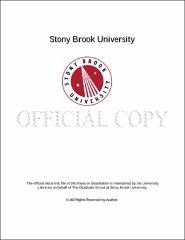| dc.identifier.uri | http://hdl.handle.net/11401/76345 | |
| dc.description.sponsorship | This work is sponsored by the Stony Brook University Graduate School in compliance with the requirements for completion of degree. | en_US |
| dc.format | Monograph | |
| dc.format.medium | Electronic Resource | en_US |
| dc.language.iso | en_US | |
| dc.publisher | The Graduate School, Stony Brook University: Stony Brook, NY. | |
| dc.type | Dissertation | |
| dcterms.abstract | In recent decades, semiconductor photocatalysis has attracted a growing attention as a possible alternative to existing methods of hydrogen production, hydrocarbon conversion and organic compound oxidation. Many types of photocatalysts have been developed and tested for photocatalytic applications. However, most of them do not have notable activity in visible light region, which limits their practical applications. Development of photocatalysts, which can be activated by visible light provides a promising way forward to utilize both UV and visible portions of solar spectrum. In this thesis, two main methods to advance visible light driven photocatalysis, such as bandgap modification through doping and co-catalyst development, are investigated. The photocatalysts studied in this thesis included CdS and SrTiO<sub>3</sub>, which were extensively investigated and characterized. Rhodium doped strontium titanate was synthesized through different preparation methods. The synthesized samples have been investigated by various characterization techniques including XRD, TEM, STEM, XPS and UV-Vis spectroscopy. The effect of preparation conditions, such as doping concentration, calcination temperature and pH have been investigated and optimized. In addition, the photocatalytic activities for hydrogen production of the samples synthesized by different preparation methods were also studied. Among the preparation methods, polymerizable complex (PC) method was found to be the most effective synthesis method for SrTiO<sub>3</sub>: Rh. The samples prepared by PC method had higher photocatalytic activity as compared to that of samples synthesized by solid state reaction method and hydrothermal method. The reasons might be attributed to more effective doping and higher surface area. The results of this work suggest that PC method can also be applied to develop other perovskite materials for photocatalytic applications. Co-catalyst development for enhancement of photocatalytic hydrogen production is also described in this dissertation. Noble metal nanoparticles have been proved to be effective co-catalysts due to their unique physical and chemical properties. Au and Pt nanoparticles with different sizes were synthesized and deposited on CdS. Sub-nanometer Au and Pt were found to be promising co-catalysts for photocatalytic hydrogen production reaction. Specifically, sub-nm Au and sub-nm Pt nanoparticles were found to enhance the photocatalytic activity in hydrogen production of CdS by 35 and 15 times respectively. Other noble metal co-catalysts, such as Ru, Pd and Rh were also deposited on CdS and their photocatalytic activities were investigated. Additionally, a novel chamber for photocatalytic reactions was developed as a part of this dissertation. The reaction chamber has several unique features allowing different reactions and measurements. The reactor was proved to be suitable for future projects in photocatalysis such as photocatalytic CO<sub>2</sub> conversion into hydrocarbons. | |
| dcterms.available | 2017-09-20T16:50:04Z | |
| dcterms.contributor | Sokolov, Jonathan | en_US |
| dcterms.contributor | Orlov, Alexander | en_US |
| dcterms.contributor | Clayton, Clive | en_US |
| dcterms.contributor | Su, Dong. | en_US |
| dcterms.creator | Shen, Peichuan | |
| dcterms.dateAccepted | 2017-09-20T16:50:04Z | |
| dcterms.dateSubmitted | 2017-09-20T16:50:04Z | |
| dcterms.description | Department of Materials Science and Engineering. | en_US |
| dcterms.extent | 186 pg. | en_US |
| dcterms.format | Monograph | |
| dcterms.format | Application/PDF | en_US |
| dcterms.identifier | http://hdl.handle.net/11401/76345 | |
| dcterms.issued | 2013-12-01 | |
| dcterms.language | en_US | |
| dcterms.provenance | Made available in DSpace on 2017-09-20T16:50:04Z (GMT). No. of bitstreams: 1
Shen_grad.sunysb_0771E_11514.pdf: 4878186 bytes, checksum: 931728c4521a19506ff3074a9a94ffb2 (MD5)
Previous issue date: 1 | en |
| dcterms.publisher | The Graduate School, Stony Brook University: Stony Brook, NY. | |
| dcterms.subject | Materials Science | |
| dcterms.subject | hydrogen production, noble metal, perovskite, photocatalysis, polymerizable, visible light | |
| dcterms.title | Development of New Generation of Perovskite Based Noble Metal/Semiconductor Photocatalysts for Visible-light-driven Hydrogen Production | |
| dcterms.type | Dissertation | |

